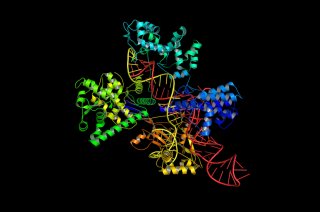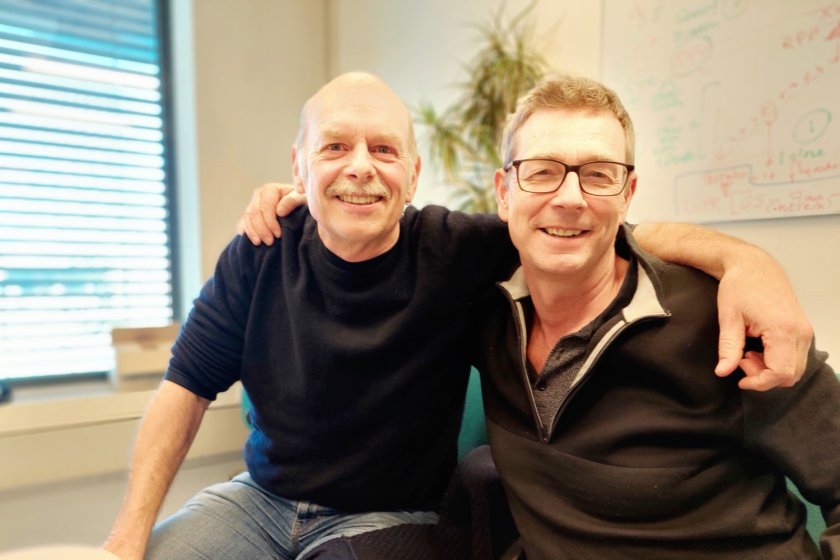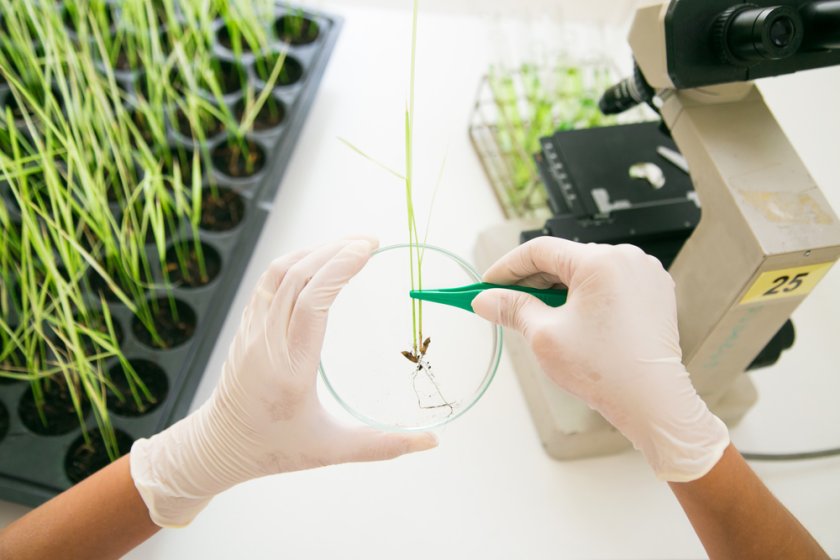
Interview
'We need a smarter governance to ensure CRISPR-Cas is used for the benefit of society and environment'
The biological technique CRISPR-Cas allows scientists to precisely edit DNA in organisms. This gene-editing technology has been making headlines in recent years due to its potential to cure genetic diseases, improve agricultural crops, and could even help combat some effects of climate change. In Europe, CRISPR-Cas has been subjected to stringent regulations. But that might change this year, when the European Commission will present a proposal for new regulations regarding CRISPR-Cas in agriculture.
What can CRISPR-Cas do for the world? Should there be additional regulations or restrictions for gene editing, how does society feel about CRISPR-Cas and what is the role of big companies? We sat down with CRISPR-Cas expert John van der Oost and interdisciplinary social scientist Phil Macnaghten to discuss this, and more.
What prospects do you see in CRISPR-Cas?
John: “I think CRISPR-Cas has a lot of potential. In agriculture, as well as in medical applications and in biotechnological research. The technology will help to generate crops that cope with the changing environment. Together with an institute in the Philippines, we are creating drought tolerant rice using CRISPR-Cas, so it can withstand climate change. That shows the promise of this gene-editing tool. However, CRISPR-Cas is not the only way to do this; we should combine it with other technologies we know and already use.”
Phil: “I see some significant prospects in CRISPR-Cas, as it is undoubtedly a powerful technology. However, it is just one available tool, not the solution to the grand challenges we face. It is not a technofix or a way to further develop industrialised monocultures. Moreover, we need to be open about what aspects of the science behind it are still unknown and communicate those in discussions with policymakers and with the wider public.”

The EU is working on a proposal concerning the regulation of precise gene editing techniques, like CRISPR-Cas. How do you feel about this?
John: “Personally, I would be in favour of relaxing the regulations concerning CRISPR-Cas in a way that simple edits at the DNA level are allowed. Especially if we are talking about small changes in the genetic material. As those could occur in nature as well, they are indistinguishable from natural variants.”
Phil: “The problem with the current debate is that it is binary: do we keep the regulations, or do we exempt CRISPR-Cas from those regulations? That is the wrong debate. We should consider the conditions under which CRISPR-Cas should be governed. So, I am not simply for or against allowing CRISPR-Cas, but I plead for a different governance system. As John quite rightly says, we should, for example, distinguish between the level of genetic intervention.”
Not everyone will be equally enthusiastic if the regulations are altered. What are the main concerns of the public?
Phil: “In the nineties, all discussions and concerns around GMO got condensed into the question: Is it safe for humans and the environment? That is in part why the debate got stuck at the time. According to our research, citizens rarely are concerned about the technology itself or exclusively concerned about its safety, but express worries about how the technology will be used and for whose benefit.
They believe CRISPR-Cas has the potential of doing wonderful things, but doubt it will be used for those reasons. Instead, they believe it will be used to benefit large companies. They also worry about unforeseen harms, the unnaturalness of it, and about the lack of democratic input in shaping the future of agriculture. Therefore, people are sceptical about relaxing the rules after which anyone on the market could use the technology.”
Given that companies aim to make a profit, is it not inevitable that they will utilise CRISPR-Cas for commercial gain?
Phil: “It is important to realise that companies are not the same entity; they all have their own culture, traditions, and values. While companies are aiming for commercial gain, at the same time they may truly want to improve the world with their innovations. They may value that more than short-term profit. Because they are in it for the long term, they can indeed make improvements. I think it is critical to open up the conversation between corporations and citizens to explore the relationship between innovations and the public good.
Unfortunately, we cannot and should not solely rely on good intentions of companies. We need to have a different, much smarter governance system that does not just govern risk and safety, but also makes sure that CRISPR-Cas is used for the right reasons.”

How can we make sure CRISPR-Cas is being used for the public interest?
Phil: “A good starting point is to make new guidelines for the use of CRISPR-Cas. Novel regulations could for example include the rule that small DNA edits with CRISPR-Cas are allowed, as long as it is in the best interest of society or the environment. That should hold true for everyone, including big companies, small ones and start-ups. That idea has been developed in Norway serves as an excellent foundation, but the question remains: what does it mean to be in the public interest? This is not straightforward.”
John: “There are examples where everybody will agree that they are in the best interest of society. For instance, the drought tolerant rice I mentioned earlier. As this rice grows better on dry land than the traditional variant, farmers will reach a higher yield and the consumers will pay less for it. Hence, it contributes to a good cause. In the more grey areas, it gets tricky indeed. Who will then decide whether a development is indeed in the best interest?”
Phil: “I think the EU should set up a new kind of committee with experts in different fields, like political scientists, ethicists and social scientists. They should make a formal assessment of contributions towards sustainability, ethics and society when it comes to new, CRISPR based products. In addition, we should educate future scientists about the role of researchers in society and what it means to be a good scientist.”
John, you mentioned small DNA edits. How do you classify levels of genetic modification and is it possible to include it in the legal framework?
John: “With CRISPR-Cas, researchers edit DNA in different ways. The tool can alter a single DNA letter (point mutation), or a short stretch of DNA. As these small alterations also occur in nature, they should be exempt from the strict GMO regulations. Inserting large pieces of DNA falls under a different level of genetic modification. A good example of that category is a maize plant in which researchers added a gene coding for a bacterial toxin (Bt) as an alternative to pesticides. You will not likely find such a combination of genetic information in natural conditions. Therefore, I think the result should be carefully tested. In the case of the maize plant, scientists showed that the toxin was harmful to insects, but not to humans or cattle who eat the corn.”

Small mutations, big consequences?
The human genome consists of over a billion DNA letters, or nucleotides. Yet, changes to one or a few of those nucleotides can result in significant outcomes. Genetic diseases like duchenne muscular dystrophy and sickle cell disease are for example caused by a change of a single DNA letter. In plants too, small mutations might limit the plant. “But it will not affect those who eat them”, says John Van der Oost. “As far as I know, such naturally occurring small mutations have never been demonstrated to produce compounds that are toxic to the people consuming it.”
In practice, scientists apply their knowledge of genes when using CRISPR-Cas. They have gained insight into the role of numerous genes through fundamental research, which enables them to introduce minor modifications in targeted segments of DNA. It is highly unlikely that this will lead to a crop that is harmful to humans.
Will a novel, smarter governance that focuses on the benefit of society, change the way scientists do research?
John: “It will be more important than ever to collaborate with different disciplines. Here at Wageningen, we do already combine fields of expertise and feel the benefits of it. Researchers like Phil, who focus on people and the public’s perception, work together with researchers like me, who focus on DNA first.”
Phil: “We should also engage more with farmers, other countries and local communities to ensure that innovations are co-designed with and for society. The earlier in the process we involve them, the better.”
John van der Oost

John van der Oost is the group leader of the Bacterial Genetics group in the Laboratory of Microbiology at Wageningen University & Research. He is renowned for his pioneering work on the CRISPR-Cas technology, which he initiated during his time at the university. For his outstanding, ground-breaking and inspiring work on CRISPR-Cas, Van der Oost received the Spinoza price in 2018.
Phil Macnaghten

Phil Macnaghten is Professor in the Knowledge, Technology and Innovation Group at Wageningen University & Research. He is an interdisciplinary social scientist working at the interface of science and technology studies, public engagement studies, governance of emerging technology, and responsible innovation. Macnaghten places great importance on ensuring that his work is accessible to natural scientists, and has successfully demonstrated his ability to do so throughout his career.